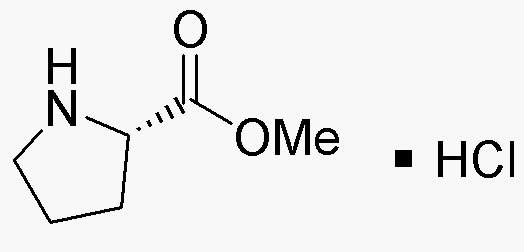L-Proline methyl ester hydrochloride is widely utilized in research focused on:
- Synthesis of Pharmaceuticals: This compound serves as an important intermediate in the synthesis of various pharmaceutical agents, particularly in the development of drugs targeting neurological disorders.
- Peptide Synthesis: It is commonly used in the synthesis of peptides, enhancing the efficiency of coupling reactions due to its ability to stabilize reactive intermediates.
- Chiral Catalysis: The compound acts as a chiral auxiliary in asymmetric synthesis, providing a means to produce enantiomerically pure compounds, which is crucial in the production of many drugs.
- Biochemical Research: Researchers utilize it to study the role of proline derivatives in biological systems, including their effects on protein folding and stability.
- Food Industry Applications: It can be used as a flavoring agent or food additive, contributing to the enhancement of taste profiles in various food products.
General Information
Properties
Safety and Regulations
Applications
L-Proline methyl ester hydrochloride is widely utilized in research focused on:
- Synthesis of Pharmaceuticals: This compound serves as an important intermediate in the synthesis of various pharmaceutical agents, particularly in the development of drugs targeting neurological disorders.
- Peptide Synthesis: It is commonly used in the synthesis of peptides, enhancing the efficiency of coupling reactions due to its ability to stabilize reactive intermediates.
- Chiral Catalysis: The compound acts as a chiral auxiliary in asymmetric synthesis, providing a means to produce enantiomerically pure compounds, which is crucial in the production of many drugs.
- Biochemical Research: Researchers utilize it to study the role of proline derivatives in biological systems, including their effects on protein folding and stability.
- Food Industry Applications: It can be used as a flavoring agent or food additive, contributing to the enhancement of taste profiles in various food products.
Documents
Safety Data Sheets (SDS)
The SDS provides comprehensive safety information on handling, storage, and disposal of the product.
Product Specification (PS)
The PS provides a comprehensive breakdown of the product’s properties, including chemical composition, physical state, purity, and storage requirements. It also details acceptable quality ranges and the product's intended applications.
Certificates of Analysis (COA)
Search for Certificates of Analysis (COA) by entering the products Lot Number. Lot and Batch Numbers can be found on a product’s label following the words ‘Lot’ or ‘Batch’.
*Catalog Number
*Lot Number
Certificates Of Origin (COO)
This COO confirms the country where the product was manufactured, and also details the materials and components used in it and whether it is derived from natural, synthetic, or other specific sources. This certificate may be required for customs, trade, and regulatory compliance.
*Catalog Number
*Lot Number
Safety Data Sheets (SDS)
The SDS provides comprehensive safety information on handling, storage, and disposal of the product.
DownloadProduct Specification (PS)
The PS provides a comprehensive breakdown of the product’s properties, including chemical composition, physical state, purity, and storage requirements. It also details acceptable quality ranges and the product's intended applications.
DownloadCertificates of Analysis (COA)
Search for Certificates of Analysis (COA) by entering the products Lot Number. Lot and Batch Numbers can be found on a product’s label following the words ‘Lot’ or ‘Batch’.
*Catalog Number
*Lot Number
Certificates Of Origin (COO)
This COO confirms the country where the product was manufactured, and also details the materials and components used in it and whether it is derived from natural, synthetic, or other specific sources. This certificate may be required for customs, trade, and regulatory compliance.


